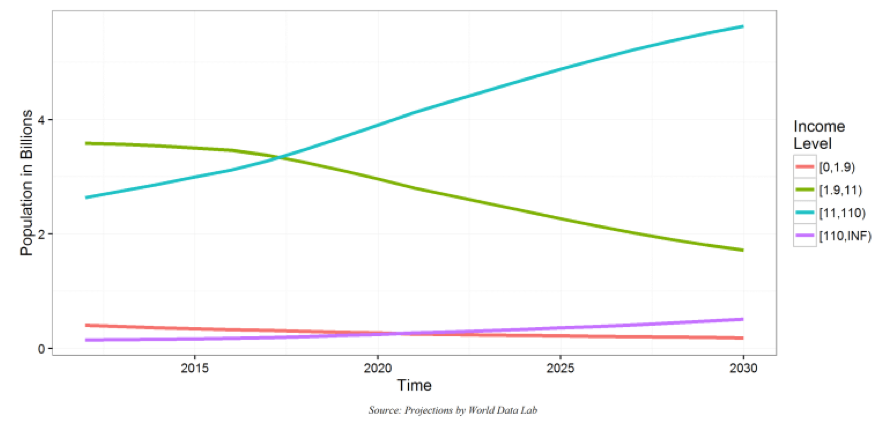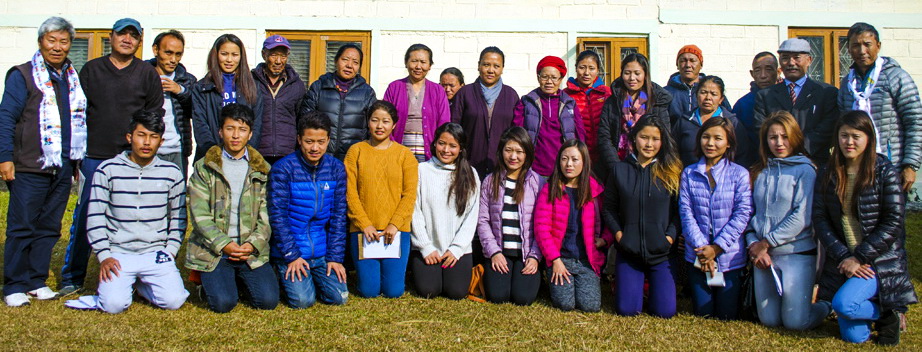More good news: the number of people with a shot at more stable, healthier lives is growing even faster than believed. Every day, demographers estimate, more than four hundred thousand people are joining the global middle class, with incomes above $11 per day. That’s approximately five people every second.
In another ten years, six of every ten people – five billion people – will be in the global middle class, earning between $11 and $110 per day, if current trends continue.
The impacts will be far-reaching for business leaders as well as policymakers, according to an eye-opening commentary published July 27 by the Global Economy and Development program at the Brookings Institution.
The article by the World Bank’s Wolfgang Fengler and Brookings’ Homi Kharas summarizes projections from new data, and was posted on Brookings’ “Future Development” blog. We highly recommend it.
Some highlights:
- The strategy of any company in the West aiming to grow its business internationally should reflect what is now a dominant global demographic phenomenon.
- Middle-class consumption across the world is $37 trillion a year, contributing more to global growth than any other element of demand.
- The expanding middle class is mainly an Asian story; 87 percent of the next billion entrants to the middle class will be Asians
- As people move up the income ladder, the group of vulnerable or “near poor” people earning between $1.90 and $11 per day is declining at an equal pace.
Policymakers and news media often focus on demographic extremes: people suffering in extreme poverty or living the lives of the rich, write authors Fengler and Kharas. Yet, more than 90 percent of world population “is part of the two groups in the middle, where most of the movement between groups is happening.” (See chart below.)
They point to the well-known facts that people entering the middle class can now afford some meat or poultry in their diet. And health care, education, insurance and even vacations. People entering the middle class “have less fear of falling back into extreme poverty should unemployment, drought, sickness or some other shock affect them.”
** **
Wolfgang Fengler is lead economist in trade and competitiveness at the World Bank. Homi Kharas is senior fellow and co-director of Brookings’ Global Economy and Development program.
“These projections are a first attempt to provide real-time estimates on which policymakers and businesses can act,” they write. “But it is only a first step, the tip of a data mountain. Real-time data models that look forward instead of only backward will be critical to help policymakers and business alike.”
To illustrate, they note that a company today with a billion customers (each earning above $11 a day in purchasing power parity) potentially could attract 1.6 billion customers by 2030 if that company were to maintain its global market share, winning new orders mainly in China and India.

Development experts typically organize the world into four income groups: extreme poor (below $1.90 per day), vulnerable or near poor ($1.90 to $11 per day), middle class ($11 to $110 per day), and rich (above $110 per day). The middle class is the “consumer class,” with buying power that drives most economies.
The chart shows at the top the soaring projection for the middle-income group and corresponding big decline in the vulnerable population. Lines at the base forecast steady increases for the rich and ongoing reductions for numbers of people living in extreme poverty.
According to the authors: “Even though some people talk of a declining middle class in the West, the truth is that the global middle class is growing at an unprecedented speed.”
Around 3.3 billion people now belong to the global middle class, according to the two analysts. They project the middle class will reach four billion by 2021, and five billion by 2027.
** **
We’ve seen in Nepal for more than two decades how access to education from early grades through high school enabled thousands of girls from poor families to find new hope for good jobs and more independence — and to take their places in this historic rise among South Asians into the global middle class.
The students in the photo above are middle-schoolers in the STOP Girl Trafficking program who live in the isolated mountains of central Nepal. The program, as we’ve written, is funded largely by American Himalayan Foundation donors and led in Nepal by the inspiring Dr. Aruna Uprety and her local partners.
In the photo below, these eleven scions (kneeling) of Tibetan families grew up in exile camps in Nepal. They are among dozens of young Tibetan exiles whose college studies are being funded by the foundation’s campaign honoring the 80th birthday of His Holiness the Dalai Lama in 2015. The “80 4 80” campaign goal: fund college studies of eighty outstanding students from Tibetan exile families.

** **
The new Fengler-Kharas study updates and broadens the analysis by Dr. Kharas we posted in March.
The authors invite readers of the new study to direct inquiries about detailed models behind their projections – models that suggest buying habits of different subgroups – via email to Martin Hofer at: martin.hofer@worlddata.io
** **
Photos courtesy of the American Himalayan Foundation
Chart credit: World Data Lab, Brookings Institution


Leave a Reply